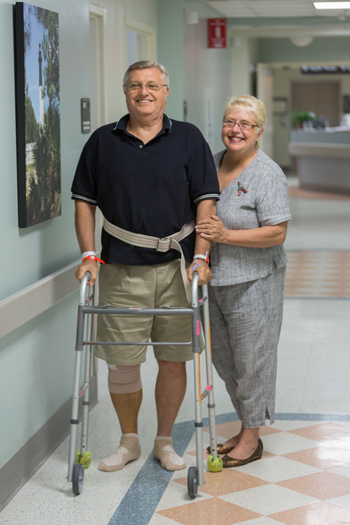After Your Joint Replacement Surgery

After joint replacement surgery, you’ll be eager to resume the active life you had before your joint became a problem. With your new joint, you’re halfway there — but you’ll need to regain the strength and balance you had previously.
Your support circle will work hard to keep you comfortable and making progress during your short hospital stay. You’ll make your way through the "Lowcountry Tour" during group physical therapy and practice strength-building exercises with rest and relaxation in between. Here’s how we’ll work together toward your independence in the hours following surgery:
Nursing
- Nurses will closely monitor your surgical recovery, checking your vital signs, surgical site and breathing.
Pain Management
- The joint care team will work with you to ensure you are as comfortable as possible by keeping your pain under control.
Diet and Medications
- Ice chips and liquid will be available at first, then a light meal later in the day. Your diet will progress as your body heals.
- You’ll receive home medications plus a clot-preventing blood thinner as ordered by your physician.
Activity
- Physical therapy and nursing staff will help you get out of bed, take a few steps, and sit in a chair for a short time after your surgery.
- Then it won't be long before you're ready to join the group physical therapy sessions.
How Fast Does Recovery Progress?
Every body is different, so recovery time varies. Here’s an average course for returning to pre-surgery wellness:
Day of Surgery
- Recovery from surgery progresses.
- Light physical activity begins.
Post-Operative Day One
- Physical activity continues and progresses.
- Group physical therapy, morning and afternoon.
- Discharge planning finalized.
- When therapy goals are met, you're ready to head home.
Post-Operative Day Two
- Physical activity increases if you weren't discharged home on day one.
- Group physical therapy continues.
- When therapy goals are met, you’re ready to head home.
At-Home Care
- Monitoring of your health and incision continues.
- Home care services as ordered by your physician begin.
- Outpatient rehabilitation begins and usually continues for six to 12 weeks.
- Our discharge checklist serves as a reminder of what to do and be safe.
Beaufort Memorial Orthopedic Rehabilitation Specialists
From your first inpatient session in the comfort of your room, to outpatient rehab at one of our convenient locations in Beaufort or Bluffton, you’ll continue regaining a life with less pain on a new, more functional joint.
Your surgeon and physical therapist will discuss your orthopaedic rehabilitation plan before you leave the hospital, so outpatient rehabilitation will be ready to help you get back to your daily life and take full advantage of your new joint.
An orthopaedic rehabilitation program can help restore the mobility and function you may have lost when joint pain limited your activities. In addition, it helps you:
- Build strength and endurance
- Improve balance
- Optimize independence
Physical and/or occupational therapists carefully add to the activities you perform to encourage your body to relearn old skills. You may find you need to do certain movements in a new way or using different muscles — therapists can help you figure out how to do this effectively. They will also watch carefully to make sure you are performing activities safely.
